I recently spent a week living beside Erwan Le Corre, Vic Verdier, Clifton Harski and eleven other MovNat attendees, training quite differently than I have for, well, anything. For the past 20 years I’ve been immersed in the triathlon and endurance arena, having competed in 20 Ironman races, including 6 Ironman Hawaii World Championships. Countless other triathlons, cycling events, trail and road races have filled up my weekends over these past two decades. The hours and hours of training as well as the lack of variety in the workouts eventually take their toll on the body both physically and mentally so I began to look for new ways to challenge myself. When I first saw Erwan’s video, “The Workout the World Forgot”, I was intrigued not just by the feats he was performing but also how he was doing them with such ease and grace, flowing barefoot over various terrains, climbing, carrying, lifting, and throwing. The workouts looked to be a better way to achieve a fit body through a total-body workout while improving balance, body awareness, and power, something I knew I lacked after so many years of focusing on endurance.
After only a short time at the West Virginia retreat I began to realize that MovNat is much more than a workout – it’s a way of life, or a way of moving through, in, and around life, if that better suits you. I quickly began to see the parallels between the MovNat system and how I live and treat patients every day in my office, and even more importantly I learned why I was really there – not to become a better athlete, but a better doctor and a better person overall. In my practice my goal is not just to fix a patient’s ailment – whether it’s a physical injury, sleep problem, or hormonal imbalance – but to improve their overall health and performance, both mentally and physically. MovNat has the same goal. Although not “treating” any ailment, the concept of submerging a person into a fully holistic and healthy lifestyle through natural movement, healthy diet, and connection with nature is one and the same.
Two of several key attributes of the MovNat system are proprioception enhancement and body repositioning
- Proprioception:
Healthy people have excellent proprioception, which is what some refer to as our sixth sense – our body position in space, as well as all our parts in relationship to one another. Healthy people have the ability to sense changes in their environment and adapt quickly and efficiently. Unhealthy people cannot do this – they quickly lose their balance and stumble, even on flat terrain, and they always look like they are working harder than they need to in order to accomplish a task. I spend a lot of time with patients correcting various imbalances so their proprioception improves. MovNat does the same, but by using basic movements we’re all born with, such as running, jumping, crawling, lifting, and throwing, in order to bring the nervous system to a higher degree of health and balance. By doing many of the movements barefoot, our kinesthetic sense is heightened. K-sense is the sensation that each nerve ending receives from our environment which affects our proprioception, and therefore our total health. It’s said to be the highest sense in an infant, and its acuity fades over the years by wearing shoes and living in an unnatural environment. MovNat can rehabilitate this sense and because those sensory connections with the brain signal the release of a slew of neuro-chemicals the result is some pretty damn good feelings. You quickly feel more balanced, more focused, and more alive during MovNat; you can’t get that drug from the pharmacy.
- Body Repositioning:
Body repositioning means you change the position of your body to enhance a specific movement as well as prevent injury. This allows you to not only perform tasks you never thought possible, such as lifting yourself up into a tree, but it allows you to use muscles you would never use in any conventional exercise. Accomplishing feats you couldn’t do just one day or one hour ago is so rewarding you’re quickly bombarded with even more healthy neurotransmitters and hormones. The high continues, and while you’re training your nervous system to process all the new sensory input, the rewards are seen as you become faster, stronger, more efficient, and yes, even leaner. It’s an all-inclusive MovNat package!
Neurology Gone Even Wilder
Skinning down MovNat even more, I was impressed with how Erwan and the guys view basic neurological concepts that are part of each and every one of us. Take, for example, a quadrapedal motion (QM), also known as the bear crawl. This cross-crawl pattern is something we’ve all done, but most likely not for a long time, so when you try to do it as an adult, you’ve got to think about it. Perform the movement going backwards and you really have to concentrate until your nervous system picks up the pattern and takes over. Who hasn’t looked right when someone asked them to look left, or been asked to step forward with their left leg and you first step with your right? Most docs would call that neurological disorganization, and it’s a sign that something is taxing the health of the nervous system. Performing a cross-crawl pattern like a QM forward, and especially backwards, is not only a great exercise for your muscular and cardiovascular systems, but it’s also a great way to balance your nervous system. Try it on your way into your next important office meeting – you’ll be more focused and sharp.
Flexibility and Focus
Just as lions don’t stretch before they attack a zebra, kids don’t stretch either (or hopefully attack a zebra). It’s not part of our human nature to have to stretch to be limber and flexible. Therefore, in MovNat, there is no stretching — at least not in practical terms. This was another pleasant surprise, as it’s a concept that I’ve preached for years and most take defense of. We stay loose, limber, and injury free through natural movement. As Erwan said one day, a child does not pick up a rock and start doing bicep curls. They throw it. After throwing, lifting, and carrying rocks I can tell you my biceps were feeling it more than they ever had from doing dumbbell curls in the gym. Conditioning through real-life movement is rewarding, fun, and demands full focus on what you’re doing, which is something many people have trouble doing every day (just look at the use of ADD meds in kids and anti-anxiety and antidepressant meds in adults).
That’s not to say that letting your mind wander during a workout is necessarily bad. For many people, including myself, it’s a time when ideas and creativity come alive. But mindfulness, a major part of MovNat, is a great way to take your mind off any of life’s stressors. Being of present moment rather than spending time fretting will reduce harmful stress hormones like cortisol and increase healthy anabolic hormones such as DHEA, testosterone, and progesterone. You almost always have to be mindful at MovNat. Running on a trail barefoot or walking across a log five feet in the air will grab your attention. If it doesn’t, the ground will.
I’ve already begun to implement MovNat not just in my own life and clinical practice but also with my three kids. It’s amazing how many people can’t do a full squat (correctly) or balance on one leg, let-alone on a 2-inch board. MovNat is a great system to complement any and every healthy lifestyle and any activity you wish to succeed in. And, as with the human body’s potential, MovNat applications are limitless, whether you want to compete in an Ironman triathlon, a pushup contest, or just be able to walk unassisted when you’re 100 years old.
Click on the photos below for descriptions.
- Lifting myself up into the tree-bar
- Swinging the leg to gain momentum
- …and up
- Press on the bar
- Balancing on the limb/bar
- Shouldering the log, balance, & squat (with someone cracking a joke)
- Readying for log lift
- Log snatch & press
- Our tribe
- Me with Cliff & Erwan (Vic not present last day)
 Consult with
Consult with Sock Doc Workshops
Sock Doc Workshops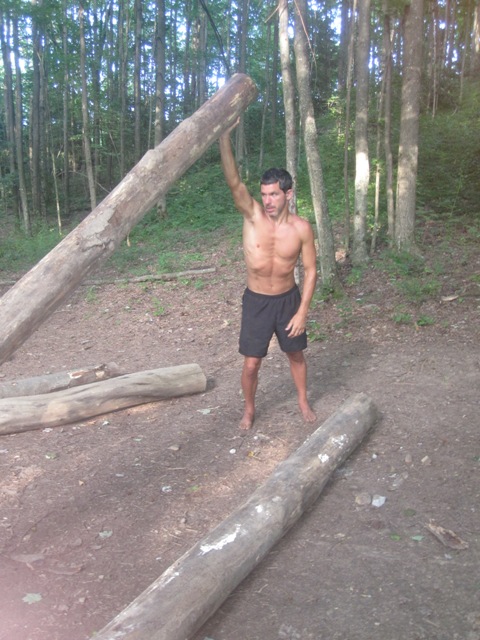
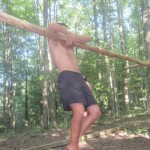
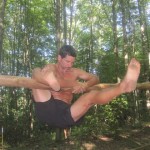
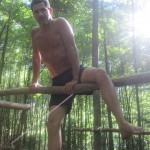
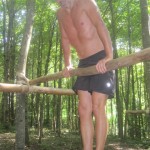
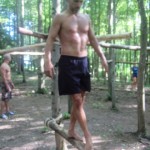
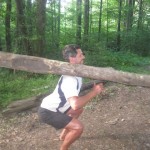
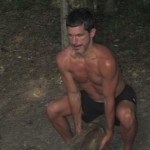
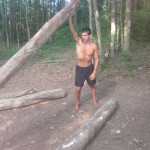
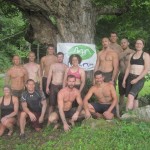
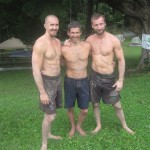
Nick says
Ah the memories…
Cynthia says
Best tent neighbour ever! Great post! I enjoyed reading it 🙂 Btw…. you are RIPPED in that ironman photo! 😉
Sock Doc says
Haha! Thanks Cilantro!
Sam Hight says
I have a background in parkour (reach and escape focus) which has it’s origins in the same Methode Naturalle foundation as MovNat. Because everything in parkour happens at a high intensity (anaerobic) I’ve noticed increasing recovery times and muscle activation imbalance. I’m curious as to whether MovNat suffers from the same over-intensity of activity?
I’ve begun experimenting with seasonalised parkour training with time off to rebuild my aerobic base. Perhaps MovNat allows for this necessary rebuilding in it’s greater range of activity than pure parkour?
On a side note, I had a great time climbing coconut trees for food in Rarotonga recently. Highly recommended location for a “natural” lifestyle. Back in a New Zealand winter is not so much fun!
Sam
Sock Doc says
Hi Sam, thanks for the comment and something I’ve been thinking about and actually one of the next posts up soon on the SD site will be “MovNat & Endurance Training”. I agree, most of it is high intensity – more specifically MovNat is periods of high intensity followed by periods of low intensity – but ultimately, it can be very anaerobic unless you’re working on balancing skills and easy swims & runs. I like the way you’re thinking and agree – that there has to be some periodization involved – you can’t be training high intensity all the time, you will burn out and get sick or injured. But you also can’t do too much aerobic too often – you’ll suffer other problems. So there is a balance, and part of that balance depends on your goals and if you’re training for an event. I am going to try to organize all these thoughts in the next MovNat post and welcome your input.
Sam Hight says
Thanks for your reply Steve (or do you prefer Sock Doc?). I’ve been slowly digesting lot of Dr. Maffetone’s material over the last few years, and more recently some of your own. A lot of these holistic concepts are really beginning to click. It’s great to know that I’m heading in the right direction.
I look forward to reading about your take on MovNat and endurance training. It will be interesting to see what I can draw from your experiences and knowledge for my parkour training. I’m particularly interested in how a healthy lifestyle can be maintained (injury-free and well into “old” age) with the regular anaerobic activity of parkour/MovNat.
Thanks again, and thanks for your fantastic resources here on sock-doc.com
Sock Doc says
Both are good. And thanks again for the nice comments!
Vlad says
Dr. Gangemi, this is an excellent write-up of MovNat. I love all the specifics you touched on, great to see your opinion on it. I did a one-day course with Clifton and have been incorporating a lot of it into my own training. Have been thinking a bit about optimum ways to mix aerobic training and MovNat so as not to overtrain, looking forward to your “MovNat and Endurance” article you mentioned. I tend to think that aerobic running and swimming are already parts of MovNat so I guess its just intensities that have to be monitored. Once again, excellent article and looking forward to more!
Sock Doc says
Thanks Vlad. And a special thanks to you since you’re the guy who first turned me on to MovNat!
Renee says
I was reading up on the movnat retreat itinerary. I noticed that one of the days you go out and do an exercise on an empty stomach. I wondered what the concept/benefit was behind this. I went and did my one hour of laps at the pool this morning on an empty stomach and I felt quite good! So, I thought there must be some kind of goodness here in doing this.
Sock Doc says
It’s good to exercise on a fasted state – if you’re fit and healthy enough to do so. I discuss this at various places on the SD site. You’ll burn more fat exercising aerobically on a fasted state. Anaerobic is fine too – but typically not as long if you’re at a high intensity.